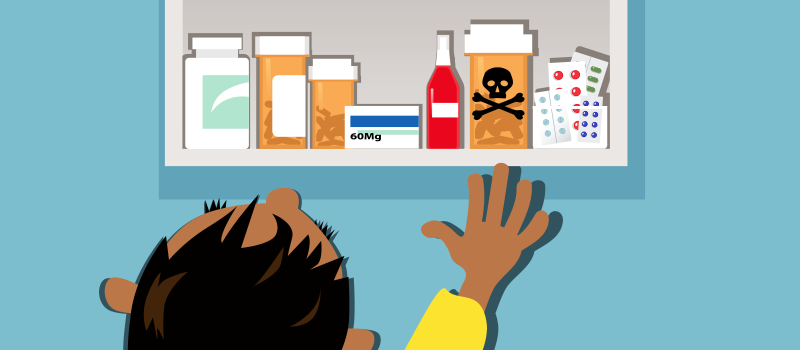What’s the Buzz
The Bee Healthy Blog
Paroxetine (Paxil) Side Effects to Know

The generic drug paroxetine hydrochloride (brand names: Paxil, Paxil CR, Brisdelle, Pexeva) is a selective serotonin reuptake inhibitor (SSRI). Selective serotonin reuptake inhibitors are used to treat depression and other mental health conditions. But like many medications, they can cause unwanted side effects. Please continue reading to find out the potential adverse effects of taking paroxetine (Paxil).
What is paroxetine used to treat?
A healthcare professional may prescribe paroxetine to treat the following conditions:
- Major depressive disorder (MDD)
- Generalized anxiety disorder (GAD)
- Panic disorder
- Social anxiety disorder/social phobia
- Obsessive-compulsive disorder (OCD)
- Posttraumatic stress disorder (PTSD)
- Premenstrual dysphoric disorder
- Hot flashes in menopausal women
How to take paroxetine?
Paroxetine comes in the form of immediate-release oral tablets, controlled-release (long-acting) tablets, and an oral suspension. It also comes in the form of a capsule sold under the brand name Brisdelle to treat hot flashes in menopausal women.
The prescribed dosage of paroxetine will be based on the condition being treated.
Generally, your doctor will prescribe the starting dose of paroxetine based on the indication. Then the dose can be increased based on your response and tolerability to side effects. A lower starting dose is typically prescribed for older adults. The dose can be increased at a 10 mg-increment weekly for the immediate-release tablets, and 12.5 mg-increment weekly for the controlled-release tablets.
Your healthcare provider will probably ask you to take paroxetine once daily in the morning. If it causes side effects such as dizziness or drowsiness, you can also take it at bedtime. Try to take the medicine at around the same time every day.
You can take paroxetine with or without food. If you develop nausea or other gastrointestinal side effects, it may help to take the medicine with food.
If you are taking the controlled-release tablets (Paxil CR), swallow the tablets whole. Do not chew, cut, or crush the long-acting tablets, as they are formulated to release the medicine at an almost constant rate over a sustained period in your body.
Shake the bottle of Paxil oral suspension (paroxetine oral suspension) well before use. Use a medication dose-measuring device such as an oral syringe to measure the dose accurately. Using a household spoon from your kitchen can result in inaccurate dosage.
It can take up to 4 weeks for you to get the full benefits of this medicine. Do not stop taking paroxetine suddenly without talking to your healthcare professional, as suddenly stopping treatment can lead to withdrawal symptoms.
What are the common side effects of Paxil?
Common side effects of Paxil (paroxetine) are listed below. Tell your healthcare professional if these side effects are severe or do not go away in a few days after your body has had a chance to get used to the medicine.
- Sexual dysfunction (low libido or decreased sex drive, delayed or absent ejaculation, inability to get an erection, other male genital disorders, and inability to have an orgasm in females)
- Gastrointestinal side effects such as heartburn, nausea, stomach pain, decreased appetite, changes in weight, constipation, or diarrhea
- Headache
- Sleep difficulties
- Dry mouth
- Increased sweating
- Dizziness
- Weakness
- Shakiness
- Nervousness
- Blurred vision
Less commonly, paroxetine can cause more serious side effects. Call your doctor immediately or seek emergency medical attention if the following symptoms occur:
- Suicidal behaviors and ideation — paroxetine has a boxed warning about the increased risk of suicidal thoughts and behaviors
- Maniac episodes presenting with dangerous impulses, acting aggressive
- Serotonin syndrome with symptoms such as confusion, fever, fast heartbeat, severe muscle stiffness, muscle twitching, problems with coordination, diarrhea, headache, insomnia, convulsions, and shivering
- Severe allergic reaction with skin rash, hives, swelling of the face, throat, or tongue, and difficulty breathing
- Abnormal bleeding or bruising
- Low blood sodium with symptoms such as confusion, headache, unusual weakness, problems with coordination, and slurred speech
- Unexplained bone pain, bruising, and swelling
- Seizures
What are the warnings for Paxil?
Some of the risks of taking Paxil include:
- Clinical worsening of depression and suicidal thoughts, especially in young adults under the age of 24 years.
- Serotonin syndrome (a potentially life-threatening condition because of too much serotonin in the body). Signs and symptoms include fever, confusion, fast heart rate, and muscle stiffness.
- Discontinuation syndrome with withdrawal symptoms such as anxiety, agitation, dizziness, trouble sleeping, and nausea. This occurs if you stop taking paroxetine suddenly.
- Serious adverse reactions from a drug combination of paroxetine and another drug. Drug interactions can occur with prescription and over-the-counter medications, for example, MAO inhibitors, thioridazine, pimozide, blood thinners (anticoagulants), nonsteroidal anti-inflammatory drugs (NSAIDs), other antidepressant medications such as tricyclic antidepressants and serotonin norepinephrine reuptake inhibitors, and many others.
- Increased risk of bleeding.
- Increased risk of a manic episode in people with bipolar disorder.
- Risk in pregnant women (harm to the unborn baby).
What are the precautions while taking paroxetine?
Precautions before starting antidepressant treatment
Tell your doctor if you have ever had allergic reactions to paroxetine, any of the active or inactive ingredients in the oral tablets or suspension, other antidepressants, or any other medications.
Give your doctor and pharmacist a complete list of your medications, including prescription drugs, over-the-counter drugs, dietary supplements, and herbal products such as tryptophan or St. John’s wort, to avoid serious drug-drug interactions.
Tell your doctor if you have a history of drug abuse, recent heart attack, low sodium, seizures, glaucoma, bleeding disorders, osteoporosis or other bone disorders, heart disease, abnormal liver function tests or severe liver dysfunction, acute renal failure, or chronic kidney disease.
Precautions during paroxetine treatment
People who have had an allergic reaction to paroxetine in the past should not take this medication.
Do not take paroxetine if you are pregnant. This medication can cause major congenital malformations and problems in the newborn baby if it is taken during pregnancy. This medication can pass into breast milk. Talk to your doctor before taking paroxetine if you are breastfeeding.
Patients treated with paroxetine may experience drowsiness, dizziness, blurred vision, and reduced concentration and judgment. Do not drive or operate machinery until you know how it affects you. Avoid drinking alcohol while on paroxetine, as it can make these side effects worse.
In case of a missed dose, take paroxetine as soon as you remember. But if it is almost time for the next dose, skip the missed dose and go back to your regular dosing schedule. Do not take an extra dose to make up for a missed dose.
Do not substitute one brand of paroxetine for another without checking with your healthcare professional first. Different products are used to treat different conditions.
Make sure you are not taking more than one medicine with paroxetine as the active ingredient — this can put you at risk of an overdose and serious adverse effects such as serotonin syndrome.
Elderly patients above the age of 65 years should discuss the pros and cons of taking paroxetine with their healthcare professional. Other safer alternatives may be available to treat their condition.
What other medications may interact with paroxetine?
Also, people who are taking thioridazine and pimozide should not take paroxetine due to the risk of serious drug interactions. More specifically, paroxetine can increase the levels of pimozide and thioridazine, which can affect the heartbeat.
Additionally, those who have taken a monoamine oxidase inhibitor (MAOI), such as methylene blue or linezolid, should not take paroxetine due to a risk of drug interactions leading to serotonin syndrome. MAOIs must be stopped for 14 days before starting paroxetine.
Other medications that can interact with paroxetine include phenytoin, cimetidine, and phenobarbital.
Avoid any medications that can cause drowsiness while taking paroxetine, as they can worsen this side effect. While taking paroxetine, talk to your doctor before taking muscle relaxers, opioid pain medicine, sleep aid, seizure medicine, and anxiety treatment.
Frequently Asked Questions About Paroxetine
Does paroxetine cause weight gain?
Paroxetine may cause weight gain in some people. In others, it can lead to a decreased appetite and weight loss. If weight gain is a concern for you despite eating a healthy diet and exercising regularly, talk to your doctor about other alternatives.
Is paroxetine a sleeping pill?
No, paroxetine is not a sleeping pill. It is an antidepressant (selective serotonin reuptake inhibitor or SSRI). It is used to treat mental health conditions such as depression, generalized anxiety disorder, panic attacks, social anxiety disorder, post-traumatic stress disorder, and premenstrual dysphoric disorder.
How does paroxetine make you feel?
Antidepressant medications like paroxetine help to improve your mood and make you less anxious. Therefore, paroxetine should make you feel better overall. After starting this medication, you may notice that you are more relaxed, less anxious, and sleeping better. However, your personality will remain the same.
What happens when you first start taking paroxetine?
Paxil can make some people feel “weird” at first. This can even be a feeling of extra anxiety, which can be worrisome since this medication is used to treat anxiety disorders. However, once your body gets used to the medicine, these feelings usually go away. If you continue to feel extra anxiety or jittery after a week, you should discuss this side effect with your healthcare professional.
References:
- https://medlineplus.gov/druginfo/meds/a698032.html#:
- https://dailymed.nlm.nih.gov/dailymed/lookup.cfm?setid=40226242-da82-4dd7-bca2-eebb14501264
- https://www.ncbi.nlm.nih.gov/pmc/articles/PMC6741642/pdf/CNS-7-25.pdf
- https://www.nature.com/articles/srep23789
- https://www.ncbi.nlm.nih.gov/pmc/articles/PMC181155/
- https://www.amjmed.com/article/S0002-9343(17)30920-8/fulltext
- https://pubmed.ncbi.nlm.nih.gov/18983224/
- https://www.ncbi.nlm.nih.gov/books/NBK526022/
- https://www.fda.gov/drugs/postmarket-drug-safety-information-patients-and-providers/suicidality-children-and-adolescents-being-treated-antidepressant-medications
- https://www.ncbi.nlm.nih.gov/pmc/articles/PMC181142/












SOCIAL